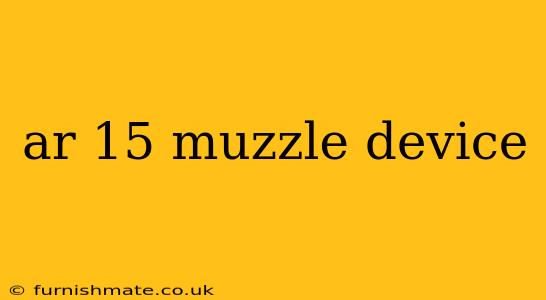Choosing the right muzzle device for your AR-15 is crucial for optimizing performance and enhancing your shooting experience. This isn't just about aesthetics; the right muzzle device can significantly impact accuracy, recoil management, and overall functionality. This comprehensive guide will delve into the various types of AR-15 muzzle devices, exploring their benefits, drawbacks, and considerations for selection.
Understanding the Role of an AR-15 Muzzle Device
An AR-15 muzzle device is attached to the end of the barrel, influencing the gases expelled after firing. This seemingly small addition significantly impacts several key aspects of shooting:
- Recoil Reduction: Many muzzle devices redirect or manipulate propellant gases to counteract recoil, leading to a smoother shooting experience and improved follow-up shots.
- Flash Suppression: Flash hiders minimize the bright muzzle flash, beneficial for night shooting and maintaining situational awareness.
- Sound Suppression: While not directly suppressing sound like a suppressor, some muzzle devices can subtly reduce perceived sound levels.
- Compensation: Compensators redirect gases upward or to the sides, mitigating muzzle rise and improving accuracy during rapid firing.
- Braking: Muzzle brakes effectively slow down the recoil impulse, making the rifle easier to control.
Types of AR-15 Muzzle Devices
Let's examine the most common types:
1. Flash Hiders
Flash hiders are designed primarily to reduce muzzle flash. They achieve this by manipulating the propellant gases to break up and extinguish the flame. While some offer minor recoil reduction, their main purpose is flash suppression.
- Benefits: Reduced muzzle flash, improved night vision.
- Drawbacks: May not offer significant recoil reduction or compensation.
2. Compensators
Compensators focus on managing recoil and muzzle rise. They achieve this by venting gases upward and/or to the sides, counteracting the upward and sideways forces generated during firing. This leads to faster target acquisition and improved accuracy during rapid fire.
- Benefits: Reduced muzzle rise, improved accuracy during rapid fire, quicker target reacquisition.
- Drawbacks: Can generate significant blast, potentially affecting shooters nearby.
3. Muzzle Brakes
Muzzle brakes are designed for aggressive recoil reduction. They typically vent gases to the sides or rearward, generating significant braking force that dramatically reduces felt recoil.
- Benefits: Significant recoil reduction, improved control, faster follow-up shots.
- Drawbacks: Can generate substantial noise and blast, potentially dangerous to those nearby. Also, the sideways blast can affect accuracy if not properly controlled.
4. Suppressors (Sound Suppressors)
While technically a different category, suppressors (also known as silencers) are often considered alongside muzzle devices. They significantly reduce the sound of gunfire, as well as the muzzle flash and recoil. However, they require legal compliance and additional considerations.
- Benefits: Significant noise reduction, reduced recoil, reduced muzzle flash.
- Drawbacks: Typically more expensive, require legal registration and compliance, can add length to the firearm.
Choosing the Right Muzzle Device
The optimal muzzle device depends on your individual needs and preferences:
- Competition Shooting: Compensators are commonly used to minimize muzzle rise and improve accuracy during rapid fire.
- Home Defense: Flash hiders are preferred by many for reduced muzzle flash in low-light environments.
- Hunting: A muzzle brake or suppressor might be preferred for reduced recoil and minimized sound signature.
- Recreational Shooting: The choice depends on personal preference, though flash hiders and compensators are popular choices.
Always check local and state laws regarding the legality of different muzzle devices before purchasing and installing them. Furthermore, proper installation is crucial for safety and optimal performance. Consult with a qualified gunsmith if you are unsure about installation.
Conclusion
Selecting an AR-15 muzzle device involves considering various factors. Understanding the differences between flash hiders, compensators, muzzle brakes, and suppressors is key to making an informed decision that enhances your shooting experience. Remember that safety should always be the priority; choose a device that aligns with your shooting needs and legal requirements, and always handle firearms responsibly.

